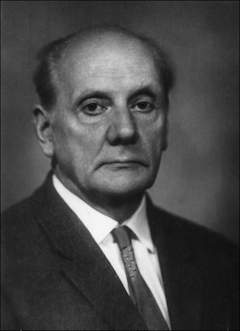- Bochvar 3-valued External Logic

Dmitry Bochvar
is a three-valued logic with values T, F, and N. is similar to , but with a special Assertion operator that always results in a classical value (T or F).
Semantics
Truth Values
Common labels for the values include:
T |
1 |
true |
N |
0.5 |
meaningless |
F |
0 |
false |
Designated Values
The set of designated values for is the singleton: { T }
Truth Tables
The value of a sentence with a truth-functional operator is determined by the values of its operands according to the following tables.
| Assertion | |||
|---|---|---|---|
| ⚬ | |||
| T | T | ||
| N | F | ||
| F | F | ||
| Negation | |||
|---|---|---|---|
| ¬ | |||
| T | F | ||
| N | N | ||
| F | T | ||
| Conjunction | |||
|---|---|---|---|
| ∧ | T | N | F |
| T | T | N | F |
| N | N | N | N |
| F | F | N | F |
| Disjunction | |||
|---|---|---|---|
| ∨ | T | N | F |
| T | T | N | T |
| N | N | N | N |
| F | T | N | F |
Defined Operators
The Conditional operator → is definable in terms of the Assertion operator ⚬:
The Biconditional ↔, in turn, is defined in the usual way:
| Conditional | |||
|---|---|---|---|
| → | T | N | F |
| T | T | F | F |
| N | T | T | T |
| F | T | T | T |
| Biconditional | |||
|---|---|---|---|
| ↔ | T | N | F |
| T | T | F | F |
| N | F | T | T |
| F | F | T | T |
The Material Conditional ⊃ is definable in terms of disjunction:
Likewise the Material Biconditional ≡ is defined in terms of ⊃ and ∧:
| Material Conditional | |||
|---|---|---|---|
| ⊃ | T | N | F |
| T | T | N | F |
| N | N | N | N |
| F | T | N | T |
| Material Biconditional | |||
|---|---|---|---|
| ≡ | T | N | F |
| T | T | N | F |
| N | N | N | N |
| F | F | N | T |
External Connectives
Bochvar also defined external versions of ∧ and ∨ using ⚬:
External Conjunction
A ∧ext B \(:=\) ⚬A ∧ ⚬B
External Disjunction
A ∨ext B \(:=\) ⚬A ∨ ⚬B
These connectives always result in a classical value (T or F). For compatibility, we use the standard internal readings of ∧ and ∨, and use the external reading for → and ↔.
Predication
A sentence with n-ary predicate \(P\) over parameters has the value:
T iff is in the extension of \(P\) and not in the anti-extension of \(P\).
F iff is in the anti-extension of \(P\) and not in the extension of \(P\).
N iff is in neither the extension nor the anti-extension of \(P\).
Quantification
Existential
The value of an existential sentence is the maximum value of the sentences that result from replacing each constant for the quantified variable. The ordering of the values from least to greatest is: F, N, B, T.
Universal
The value of an universal sentence is the minimum value of the sentences that result from replacing each constant for the quantified variable. The ordering of the values from least to greatest is: F, N, B, T.
Consequence
Logical Consequence is defined in terms of the set of designated values { T }:
Logical Consequence
C is a Logical Consequence of A iff all models where A has a desginated value are models where C also has a designated value.
Tableaux
tableaux are built similary to .
Nodes
Nodes for many-value tableaux consiste of a sentence plus a designation marker: ⊕ for designated, and ⊖ for undesignated.
Trunk
To build the trunk for an argument, add a designated node for each premise, and an undesignated node for the conclusion.
Closure
Rules
In general, rules for connectives consist of four rules per connective: a designated rule, an undesignated rule, a negated designated rule, and a negated undesignated rule. The special case of negation has a total of two rules which apply to double negation only, one designated rule, and one undesignated rule.
Operator Rules
⚬ Rules
¬ Rules
∧ Rules
∨ Rules
⊃ Rules
≡ Rules
→ Rules
↔ Rules
Quantifier Rules
∃ Rules
∀ Rules
Notes
Unlike , has some logical truths. For example (A → B) ∨ ¬(A → B). This logical truth is an instance of the Law of Excluded Middle.
The Assertion operator ⚬ can express alternate versions of validities that fail in . For example, A ⊢ A ∨ ⚬B in , which fails in .
References
D. A. Bochvar published his paper in 1938. An English translation by Merrie Bergmann was published in 1981. On a three-valued logical calculus and its application to the analysis of the paradoxes of the classical extended functional calculus. History and Philosophy of Logic, 2(1-2):87-112, 1981.
For further reading, see:
Rescher, N. (1969). Many-valued Logic. McGraw-Hill.
Beall, Jc Off-topic: a new interpretation of Weak Kleene logic. 2016.